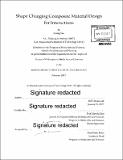| dc.contributor.advisor | Hiroshi Ishii. | en_US |
| dc.contributor.author | Yao, Lining | en_US |
| dc.contributor.other | Program in Media Arts and Sciences (Massachusetts Institute of Technology) | en_US |
| dc.date.accessioned | 2017-06-06T19:23:50Z | |
| dc.date.available | 2017-06-06T19:23:50Z | |
| dc.date.copyright | 2017 | en_US |
| dc.date.issued | 2017 | en_US |
| dc.identifier.uri | http://hdl.handle.net/1721.1/109657 | |
| dc.description | Thesis: Ph. D., Massachusetts Institute of Technology, School of Architecture and Planning, Program in Media Arts and Sciences, 2017. | en_US |
| dc.description | Cataloged from PDF version of thesis. | en_US |
| dc.description | Includes bibliographical references (pages 258-274). | en_US |
| dc.description.abstract | This thesis is about designing shape change composite material for interactions. Interaction has gone beyond computer screens and electronics to enter the realm of physical materials. Shape changes at the micro level will cause shape changes and other physical property changes at the macro level. A design strategy for bioinspired shape-changing composite materials includes two development steps: a shape-changing material unit (SCMUnit), followed by a shape-changing matrix composite (SCMC). SCMC contains the matrix phase and the dispersion phase, one of which is composed of SCMUnits. In addition, SCMC can be hierarchical, while SCMC and SCMUnits have a relationship of recursive embodiment. Two major projects exemplify how water-responsive shape-changing material can be used to design interactions based on the outlined design strategy. bioLogic is about hygromorphic bacteria-based SCMC, while Transformative Appetite is about water-driven edible SCMC material. Programmable transformations, multilayer composites and sequential-foldings were engineered with these materials. A customized fabrication strategy, combining wet lab processes and additive manufacturing, was introduced, while applications were presented to exemplify various interaction scenarios. In addition, the SCMC design strategy has been adapted to develop shape-changing materials beyond water responses. Stimuli and responsive behaviors are used to categorize these materials. A design space for nature-inspired responsive material design for shape-changing interfaces was outlined from two aspects: the technical aspects and the conceptual aspects. The technical aspects are identified with the interplays of three features of nature: natural structural mechanisms, natural stimuli and natural transformation mechanisms. The conceptual aspects is summarized in two conceptual spaces: microscale shape changes for macroscale shape changes, and microscale shape changes for macroscale material property changes. | en_US |
| dc.description.statementofresponsibility | by Lining Yao. | en_US |
| dc.format.extent | 289 pages | en_US |
| dc.language.iso | eng | en_US |
| dc.publisher | Massachusetts Institute of Technology | en_US |
| dc.rights | MIT theses are protected by copyright. They may be viewed, downloaded, or printed from this source but further reproduction or distribution in any format is prohibited without written permission. | en_US |
| dc.rights.uri | http://dspace.mit.edu/handle/1721.1/7582 | en_US |
| dc.subject | Program in Media Arts and Sciences () | en_US |
| dc.title | Shape changing composite material design for interactions | en_US |
| dc.type | Thesis | en_US |
| dc.description.degree | Ph. D. | en_US |
| dc.contributor.department | Program in Media Arts and Sciences (Massachusetts Institute of Technology) | en_US |
| dc.identifier.oclc | 987246860 | en_US |
